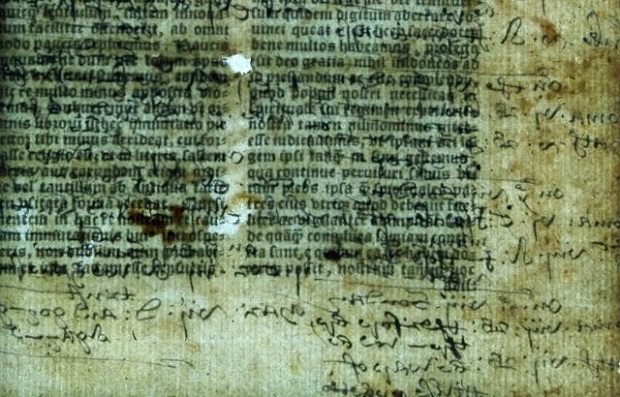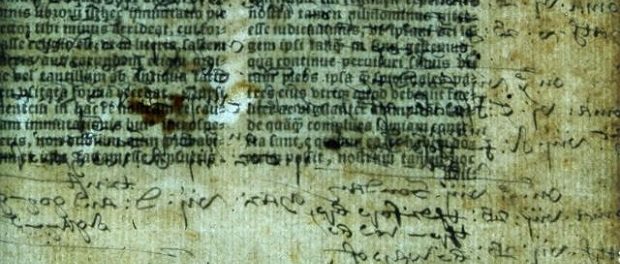[dropcap style=”font-size:100px; color:#992211;”]D[/dropcap]eciphering the scribbled-in annotations on a Reformation-era bible by x-ray to uncover a separate narrative involving pickpockets and hangings at Tyburn gallows.
Time is a harsh mistress. Twenty years ago that would have been a sure-thing plot for a shit-tier bestseller historical fiction novel schlepped for a seven-figure advance and additional movie rights before glutting the 3 for 2 table at Waterstones for the rest of the 90s.
Alas, for the Kindle era it will need at least a pair of helicopters and a rape scene.
The annotations were discovered in England’s first printed Bible, published in 1535 by Henry VIII’s printer. It is one of just seven surviving copies, and is housed in Lambeth Palace Library, London. The secrets hidden in the Lambeth Library copy were revealed during research by Dr Eyal Poleg, a historian from Queen Mary University of London.
“We know virtually nothing about this unique Bible – whose preface was written by Henry himself – outside of the surviving copies. At first, the Lambeth copy first appeared completely ‘clean’. But upon closer inspection I noticed that heavy paper had been pasted over blank parts of the book. The challenge was how to uncover the annotations with out damaging the book” said Dr Poleg.
out damaging the book” said Dr Poleg.
Dr Poleg sought the assistance of Dr Graham Davis, a specialist in 3D X-ray imaging at QMUL’s School of Dentistry. Using a light sheet, which was slid beneath the pages, they took two images in long exposure – one with the light sheet on and one with it off.
The first image showed all the annotations, scrambled with the printed text. The second picture showed only the printed text. Dr Davis then wrote a novel piece of software to subtract the second image from the first, leaving a clear picture of the annotations.
The annotations are copied from the famous ‘Great Bible’ of Thomas Cromwell, seen as the epitome of the English Reformation. Written between 1539 and 1549, they were covered and disguised with thick paper in 1600. They remained hidden until their discovery this year. According to Dr Poleg, their presence supports the idea that the Reformation was a gradual process rather than a single, transformative event.
“Until recently, it was widely assumed that the Reformation caused a complete break, a Rubicon moment when people stopped being Catholics and accepted Protestantism, rejected saints, and replaced Latin with English. This Bible is a unique witness to a time when the conservative Latin and the reformist English were used together, showing that the Reformation was a slow, complex, and gradual process.”
The annotations were written during the most tumultuous years of Henry’s reign. The period included the move away from the Church of Rome, The Act of Supremacy, the suppression of the monasteries, and the executions of Anne Boleyn, Thomas More, and John Fisher, as well as the Pilgrimage of Grace, which moved Henry to a more cautious approach.
Dr Poleg was also able to trace the subsequent life of the book, after the point at which Latin Bibles had definitively fallen out of use. On the back page he uncovered a hidden, handwritten transaction between two men: Mr William Cheffyn of Calais, and Mr James Elys Cutpurse of London. Cutpurse, in medieval English jargon, means pickpocket. The transaction states that Cutpurse promised to pay 20 shillings to Cheffyn, or would go to Marshalsea, a notorious prison in Southwark. In subsequent archival research, Dr Poleg found that Mr Cutpurse was hanged in Tybourn in July 1552.
“Beyond Mr Cutpurse’s illustrious occupation, the fact that we know when he died is significant. It allows us to date and trace the journey of the book with remarkable accuracy – the transaction obviously couldn’t have taken place after his death,” said Dr Poleg.
He added: “The book is a unique witness to the course of Henry’s Reformation. Printed in 1535 by the King’s printer and with Henry’s preface, within a few short years the situation had shifted dramatically. The Latin Bible was altered to accommodate reformist English, and the book became a testimony to the greyscale between English and Latin in that murky period between 1539 and 1549.
“Just three years later things were more certain. Monastic libraries were dissolved, and Latin liturgy was irrelevant. Our Bible found its way to lay hands, completing a remarkably swift descent in prominence from Royal text to recorder of thievery.”
Source: Eurekalert/Queen Mary, University of London
Image: © Lambeth Palace Library

Some of the news that we find inspiring, diverting, wrong or so very right.




















